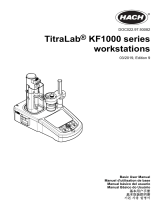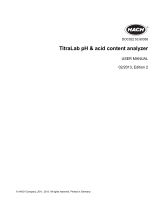
7. Make sure that the icon at the bottom of the display is highlighted. Do the instructions that
show on the display adjacent to this icon. Refer to Connect the sensor on page 13 to make sure
that the tubes and sensor are correctly aligned.
8. Push Start to start the measurement. Measurement data shows on the display.
9. If the default stirring speed needs to be adjusted, push the up and down arrow keys to increase or
decrease the speed.
Note: This adjustment only applies to the current operation. The standard default stirring speed for the
application is not changed.
10. Two options are available during the procedure:
Option Description
Stop Aborts the measurement and no results are calculated. If selected during the Replicate Sample
option, then all data in the series is lost.
Skip Stops the current operation and goes directly to the next step in the procedure. Results are then
calculated from measurement data available before Skip is selected. Results can be less accurate
using this option.
11. When the measurement is complete, push the arrow keys to see the different measurement
views.
12. Push Next for these options:
Option Description
Replicate
Sample
Use this option to start the same titration on the same sample. This is used to study the
repeatability by successively analyzing several parts of the same sample. At the end of
each measurement, a window shows the average value, the standard deviation and the
relative standard deviation.
New Sample Use this option to start the same titration on a new sample. No standard deviation or
relative standard deviation measurements will be done.
13. Push Exit to go back to the home screen.
Syringe verification
Use the syringe verification option to examine the syringe accuracy based on the ISO 8655 standard.
Note: A license key is necessary to enable the syringe verification option on the instrument. Contact the
manufacturer or a sales representative to get a license key.
1. From the home screen, select Settings, then push Select.
2. From the settings screen, select Options, then push Select.
3. Push the left or right arrow key to select the expert mode, then push Done.
4. From the home screen, select Maintenance, then push Select.
5. From the maintenance screen, select Syringe verification, then push Select.
6. When the option is selected for the first time, enter the license key.
7. Follow the procedure supplied with the syringe verification kit. For additional information, refer to
the expanded version of this manual.
Manage the data log
To select data to view, delete or export, specify data filters
1. From the home screen, select Data log.
2. Select an option, then push Select.
Option Description
View data log Views measurement data. Select individual lines of data to view more content.
22 English

























